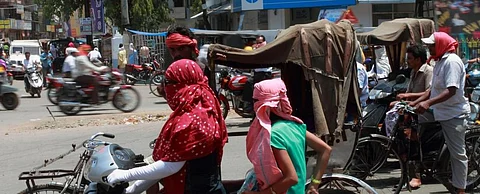

After an extremely rainy March, India is all set for a warmer-than-usual summer season from April to June.
There might be a sudden uptick in maximum temperatures recorded across the country from April 1 onwards, according to the India Meteorological Department’s (IMD) bi-weekly forecast on March 26, 2020.
Average maximum temperatures are likely to be warmer than usual by 0.5-1 degrees celsius (°C) for April-May-June according to the latest seasonal outlook for temperatures released by IMD.
These temperatures will be warmer-than-usual over east and west Rajasthan, west Madhya Pradesh, Gujarat, Konkan and Goa, Madhya Maharashtra, Marathawada, north and south interior Karnataka, coastal Karnataka, Rayalaseema and Kerala.
There is also a 40 per cent probability of maximum temperatures in the core heat wave zone during April to June 2020 to be above normal.
Core heat wave zone covers the states of Punjab, Himachal Pradesh, Uttarakhand, Delhi, Haryana, Rajasthan, Uttar Pradesh, Gujarat, Madhya Pradesh, Chhattisgarh, Bihar, Jharkhand, West Bengal, Odisha and Telangana and the meteorological subdivisions of Marathawada, Madhya Maharashtra and coastal Andhra Pradesh. This would also mean that there are above-normal chances of heat waves in these areas.
Another indication of warm temperatures over the Indian subcontinent is the change in the nature of the El Nino Southern Oscillation conditions from neutral to warm neutral over the equatorial Pacific Ocean. This means sea surface temperatures in that region of the Pacific Ocean are slightly above normal.
El Nino, that is the unusual warming of the equatorial Pacific Ocean, disrupts global wind patterns, affecting climatic conditions in tropical areas like Africa, sub-tropical areas like India as well as the extra-tropical areas like North America.
In India, there is a relationship between El Nino events and hotter-than-usual summers, along with a decrease in rainfall during the monsoon. Most of the time, these events have also led to drought conditions.
The IMD had made a similar forecast at the beginning of March for March-April-May that did not come to fruition, at least for the month of March.
The temperatures in the last week of March have been lower than normal by 2-4°C in the north, north-western, central, central peninsular and eastern parts of the country. Temperatures were above normal by 2-4 degree celsius in northern parts of Kashmir, the east and west coasts and northeastern parts of the country, which hints at the onset of the summer season.
In fact, the temperatures have been lower than normal throughout the month of March, mainly because of excessive rainfall in large parts of the country, often accompanied by thunder, lightning and hail. The reason for the rainfall was a flurry of western disturbances that came into the country and induced cyclonic circulations, that were also fed with moisture due to the anti-cyclones in the Bay of Bengal.
Data from IMD shows that by March 31, 403 districts across the country, 60 per cent of the total, have received large excess rainfall — greater than 60 per cent more than normal for this time of the year.
Almost all the districts in Uttar Pradesh, Haryana, Punjab, Rajasthan, Uttarakhand, Himachal Pradesh, Bihar, Jharkhand, Odisha and Chattisgarh have had large excess rainfall.
On the other hand, 28 per cent of the districts in the country have had deficient (40-60 per cent below normal), large deficient (> 60 per cent below normal rainfall) or no rainfall. This was mainly observed in the northeastern and southern regions of the country that also witnessed above-normal temperatures.
For instance, all the districts of Manipur and Tripura have had large deficient rainfall. Nineteen out of the 27 districts in Assam and eight out of 11 districts in Nagaland also received either large deficient or no rainfall. The entire state of Mizoram has received next to no rainfall, with a deficiency of 99 per cent below normal.
Only seven per cent of the country has had normal rainfall in March, showing the great disparity in the distribution of rainfall. This character is similar to what has been reported during the southwest monsoon season, which begins from June, in the past few years.